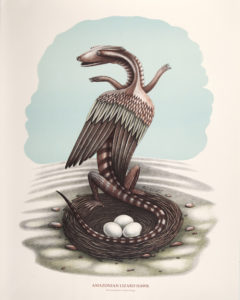The McClung plays a big role in the UT experience for many members of our campus community. To highlight these connections, we asked UT faculty and staff to tell us about an object in our collection that has impacted their classes, their students, or their own exploration within the museum.

“Amazonian-Lizard-Hawk” from the “Ornithological Quadrupeds” series, 2012, Beauvais Lyons, Lithograph, Courtesy of the artist.
Many faculty find primary source material for their scholarship and research within the McClung Museum’s Collections. This inspiration extends to Chancellor’s Professor Beauvais Lyons from the UT School of Art. Rather than a single object though, Lyons chose to highlight a particular pair of creators: John and Elizabeth Gould.
The Goulds were a pioneering couple whose talents included illustration, natural history observation, and taxidermy. Their most famous research and artwork culminated in publications like Birds of Asia and Birds of New Guinea.
“The history of prints and the history of science are closely aligned, as scientific knowledge has been advanced and peer reviewed through the reproducible image. The McClung Museum of Natural History and Culture has an impressive collection of ornithological prints, mostly intaglios and lithographs,” states Lyons.

“Great Racket-tailed Parrot; Prioniturus flavicans,” Plate 13 from”Birds of Asia” Volume VI, John Gould, Lithograph, McClung Museum Purchase, 1961.15.10.
He continues: “In particular…the British naturalist John Gould (1804-1881), who was assisted in the lithographic bookplates by his wife Elizabeth…have a special place for me.”
Lyons points out that Elizabeth Gould’s (1804–1840) accomplishments were especially notable because she only lived to the age of thirty-seven. John’s scholarship relied on his wife, Elizabeth. A gifted artist, she would take John’s rough sketches, and translate them into detailed drawings. Her drawings were then transferred to a lithographic stone. She would pull a print for John to approve before final production and coloring. Oftentimes, Elizabeth did not get credited for her artistic contributions.
Elizabeth Gould’s story and artwork has been found compelling a new generation of scholars and art makers as well. The exhibition Between the Earth and Sky highlights Elizabeth Gould’s art, and was curated by one of Lyons’ own students–– Erin Wohletz. Wohletz developed the exhibition while working toward their MFA in the School of Art under Lyons, and serving as the museum’s Collections Graduate Research Assistant. Their scholarship at the McClung led to the aforementioned exhibition and partially influenced their final MFA thesis.
Lyons describes how the Goulds influenced his personal scholarship. When talking about their prints, he states: “These works informed my series of lithographic prints, Ornithological Quadrupeds, a series of prints of imaginary four-legged birds completed as part of my ‘Association for Creative Zoology’ project a few years ago.”
Lyons’ print series was recently accessioned by the McClung Museum to celebrate this connection to our collection. They are being shown alongside Wohletz’s exhibition celebrating Elizabeth Gould in a companion display, Ornithological Quadrupeds (curated by yet another Graduate Research Assistant at the McClung, Sadie Counts). Having direct influence of the research and work of artists, curators, and students at UT is a critical touchstone for the McClung Museum. Such profound overlaps in scholarship are a critical niche for academic museums like our own.